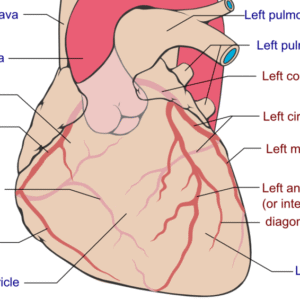Cardiology > Traumatic Aortic Dissection
Traumatic Aortic Dissection
Background
Traumatic aortic dissection is a life-threatening condition characterized by a tear in the intimal layer of the aorta due to high-impact blunt trauma. Unlike spontaneous dissection, this condition is caused by mechanical forces—typically rapid deceleration—leading to separation of the aortic wall layers and the formation of a false lumen. It most often affects the aortic isthmus and may result in rupture, hemorrhage, or end-organ ischemia.
Classification/Types
By Location
- Aortic Isthmus (most common): Just distal to the origin of the left subclavian artery.
- Ascending Aorta: Rare but more fatal if involved.
- Descending Thoracic Aorta: May extend to the abdominal aorta.
By Extent
- Partial Thickness (Intramural Hematoma): No intimal flap visible, but blood within the media.
- Complete Dissection: Intimal tear with blood flowing in both true and false lumens.
By Associated Injury
- Isolated Aortic Injury
- Polytrauma with Aortic Involvement: Rib fractures, pulmonary contusion, spinal injury.
Pathophysiology
The aorta is vulnerable at fixed points, particularly the isthmus, where it is tethered by the ligamentum arteriosum. High-energy trauma, like a motor vehicle crash, causes sudden deceleration, leading to shear stress between mobile and fixed segments. This results in tearing of the intima and media, with possible hematoma formation, false lumen propagation, or complete rupture into the mediastinum or pleural space.
Epidemiology
- Occurs in 1–2% of blunt trauma admissions.
- Accounts for up to 30% of immediate deaths in high-speed vehicular accidents.
- Over 80% of traumatic dissections occur at the aortic isthmus.
- Majority of patients are young to middle-aged adults involved in high-velocity collisions.
Etiology
I) Causes
- Motor vehicle collision (sudden deceleration injury)
- Fall from significant height
- Blast injuries
- Crush injuries to the thorax
II) Risk Factors
- High-speed trauma
- Improper seatbelt use
- Osteoporotic or weakened aortic walls in elderly
- Coagulopathy or anticoagulant use
Clinical Presentation
I) Symptoms
Sudden, severe chest or back pain
Dyspnea
Syncope or altered mental status
Hoarseness (due to recurrent laryngeal nerve involvement)
Abdominal pain (if dissection extends distally)
II) Signs
- Hypertension or hypotension
- Pulse deficit between limbs
- Harsh systolic murmur over the thorax
- Widened mediastinum on chest x-ray
- Neurologic deficits (spinal cord ischemia or stroke)
- Signs of shock or hemothorax
Differential Diagnosis (DDx)
- Aortic transection
- Spontaneous aortic dissection (non-traumatic)
- Myocardial contusion or rupture
- Pericardial tamponade
- Pulmonary embolism
- Hemopneumothorax
- Vertebral fracture with spinal shock
Diagnostic Tests
Baseline/Monitoring
- Chest X-ray: Widened mediastinum, obscured aortic knob, apical cap, pleural effusion (suggestive of hemothorax)
- CT Angiography (CTA) of Chest: Gold standard for diagnosis; reveals intimal flap, false lumen, pseudoaneurysm
- Transesophageal Echocardiography (TEE): Useful in unstable patients; detects flap, aortic dilation, effusion
- ECG: Often normal or shows signs of associated myocardial injury
- FAST or Extended FAST: May reveal hemothorax or pericardial effusion
Monitoring
- Serial hemoglobin/hematocrit
- Continuous cardiac and hemodynamic monitoring
- Blood gas and lactate to assess perfusion status
Treatment
I) Acute Management
- Airway and Breathing: Secure airway; oxygenation
- Circulation: Maintain permissive hypotension (SBP 100–120 mmHg) to reduce shear stress
- Beta-blockers (e.g., Esmolol): To reduce heart rate and aortic wall stress
- Vasodilators (e.g., Nitroprusside): If needed after beta-blockade
- Analgesia: Morphine to control pain and stress response
- Analgesia: Morphine to control pain and stress response
II) Definitive Therapy
- Endovascular Repair (TEVAR): Preferred in stable patients; minimally invasive
- Open Surgical Repair: Required in unstable patients or where TEVAR is contraindicated
- Conservative Management: Only in contained injuries with no signs of rupture or instability
Medications
Purpose | Examples | Notes |
Beta-blockers | Esmolol, Labetalol | First-line to reduce aortic shear |
Vasodilators | Nitroprusside, Nicardipine | After beta-blockade if hypertension persists |
Analgesics | Morphine | Blunts sympathetic response |
Blood Products | PRBCs, FFP | In setting of hemorrhage |
Device Therapy (Related Considerations)
- Mechanical Ventilation: For respiratory compromise or altered mental status
- Chest Tube: If hemothorax is present (do not place blindly)
- Endovascular Stent Graft: For definitive repair
- Surgical Drainage: If mediastinal hematoma compromises structures
Patient Education, Screening, Vaccines
- Emphasize seatbelt safety and trauma prevention
- Educate families about prognosis and long-term vascular monitoring
- Routine vaccinations for hospitalized or critically ill patients
Consults/Referrals
- Cardiothoracic Surgery: For open or endovascular repair
- Trauma Surgery: For multisystem injuries
- Cardiology: For dissection surveillance and postoperative care
- ICU: For hemodynamic monitoring and respiratory support
Follow-Up
Short-Term
- ICU monitoring post-repair
- Daily labs, chest imaging
- Serial CTA to monitor for leak or graft complications
Long-Term
- Regular surveillance imaging (CTA or MRI)
- Blood pressure control and beta-blocker continuation
- Vascular surgery or cardiology follow-up
- Lifestyle modification: smoking cessation, activity restriction as needed
Prognosis
- Without Treatment: Mortality exceeds 80% within 24 hours for complete transection
- With TEVAR: Survival improved to 90–95% in stable patients
- With Open Surgery: Higher morbidity, but life-saving in unstable patients
- Outcomes depend on extent of dissection, rapidity of diagnosis, and presence of associated injuries
Stay on top of medicine. Get connected. Crush the boards.
HMD is a beacon of medical education, committed to forging a global network of physicians, medical students, and allied healthcare professionals.

